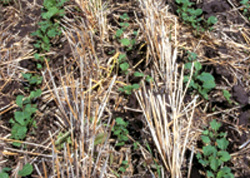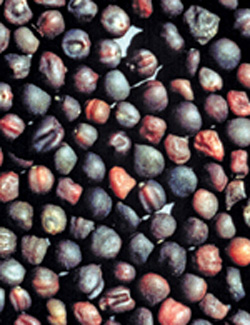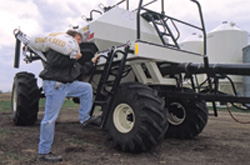
Features
Agronomy
Corn
Target the optimum hybrid seeding rate
With the high cost of hybrid canola seed, the temptation is to cut back on seeding rates to shave input costs: you might be leaving yield on the table.
November 29, 2007 By Bruce Barker
 |
| Target seven to 14 plants per square foot for the most stable yield platform. Photo Courtesy Of Bruce Barker. |
Always on the look out for ways to reduce input costs, many growers have shaved
hybrid canola seeding rates with the belief that hybrid vigour would look after
the reduced plant populations. While that theory has some validity, seeding
rates can hit a threshold where plant populations are too low to provide a stable
yield platform for the crop.
"I would agree with the thought that some growers are cutting rates too
far," says Doug Moisey, an agronomist with the Canola Council of Canada
at St. Paul, Alberta.
Moisey's responsibilities at the Canola Council include assessing canola stand
establishment. He says that several research studies currently in progress are
looking at seeding rates of hybrid canola, compared to open-pollinated varieties.
Moisey says that research at Agriculture and Agri-Food Canada (AAFC) at Saskatoon
by research scientist, Bob Elliott is showing that hybrids do have better emergence
than open-pollinated varieties, by five to 10 percent. Other research at AAFC
Lacombe found that the hybrid canola InVigor 2153 emerged at a rate ranging
from 37 to 63 percent compared to the open-pollinated canola Exceed at 37 to
55 percent. But does that mean you can shave seeding rates from what you were
accustomed? The answer lies in understanding how seeding rate affects plant
population.
 |
| Seed size varies in canola. Photo Courtesy Of The Canola Council Of Canada. |
Target plant populations of seven to 14 plants per
square foot
"Research is indicating that five plants per square foot is the critical
level and plant populations below five can result in decreased yields and contribution
margins if field conditions are not ideal due to weather, insect, or disease,"
explains Moisey. "I recommend growers target seven to 14 plants per square
foot."
Moisey likes to target above seven plants per square foot because typically
a few plants are lost during the growing season. "If you target five plants
and lose one or two plants per square foot, you will risk yield and lengthen
maturity, and at these lower plant populations, weed control and insect control
become critical. Setting a target of at least seven plants per square foot allows
for some plant loss, but it will still be above the critical level of five plants
per square foot."
The problem with setting a standard seeding rate is that not all canola seed
is the same size. Hybrids generally have a larger seed size than open-pollinated
canola, so if you seed them at the same pounds per acre rate, you will get fewer
hybrid seeds per square foot.
Elliott's work at the AAFC Saskatoon Research Centre is comparing seeding rates
and plant populations for open-pollinated to hybrids, with variables such as
conventional and zero-till. His final analysis should be available in early
2007.
The biggest shift in thinking has to come in forgetting about seeding rates
and concentrating on targetting plant populations. Once growers shift to that
way of thinking, they can then develop a strategy to decide on how many pounds
per acre to seed.
 |
| Target plant populations, not seeding rates. Photo Courtesy Of The Canola Council Of Canada. |
The final plant population established in the field depends on a wide range
of agronomic factors, in addition to seed size. Seedbed condition, moisture,
temperature, depth of seeding, seed vigour, seed germination, insects and diseases
can all play a role in reducing plant populations. The Canola Council has a
fact sheet published on its web site, called Estimated Canola Plant Populations
under Various Seeding Conditions, that shows how several factors like germination
percentage and seed size can influence targetted plant stands.
For example, under good growing conditions where 75 percent of the seeds emerge,
and a seeding rate of five pounds per acre is used for a relatively large seed
size of 5.5 grams per Thousand Seed Weight (TSW), the estimated plant population
would be borderline at around 7.1 plants per square foot. However, typical average
emergence for canola seed is more like 50 percent, according to the Canola Council,
and in this case, the estimated plant population would be 4.7 plants per square
foot – possibly good enough for a decent yield if everything goes well,
but on the low side if flea beetles, disease or tough weather conditions develop.
Estimated seeding rates in pounds per acre can be calculated using the following
formula provided by the Canola Council.
Seeding rate (lb/ac) = [9.6 x desired plant population (plants/sq.ft)
x TSW (grams)] divided by estimated seed survival (percent) expressed as a whole
number (i.e. 50 percent).
A seeding rate calculator is also available on-line at Alberta Agriculture,
Food and Rural Development's web site.
Moisey says understanding seed size and field conditions will help growers
determine optimum seeding rate. "A small seed won't do as well as a large
seed at deeper seeding depths, or if a soil is cold for a prolonged period after
planting, because the smaller seed doesn't have the sufficient energy and nutrient
reserves to overcome the additional stress."
Aiming for the most dependable plant population
In the Canola Council's Grower's Manual, a chart shows the yield curve of canola
as it relates to plants per square foot. While it shows that a stand of around
five or six plants per square foot can produce optimum yield, it also shows
that achieving a targetted plant population of 10 to 15 plants per square foot
has the least variability in yield.
Moisey also recommends that growers should go out and conduct plant population
counts 21 days after emergence, and to keep track of seeding rates, TSW and
targetted and actual plant populations. Those numbers help to estimate seedling
survival and can be used as benchmarks for future fine-tuning of the system.
"Good managers have successfully shaved seeding rates, but they are still
targetting optimum plant populations. Their experience and knowledge of how
to get optimum emergence makes the difference," explains Moisey.